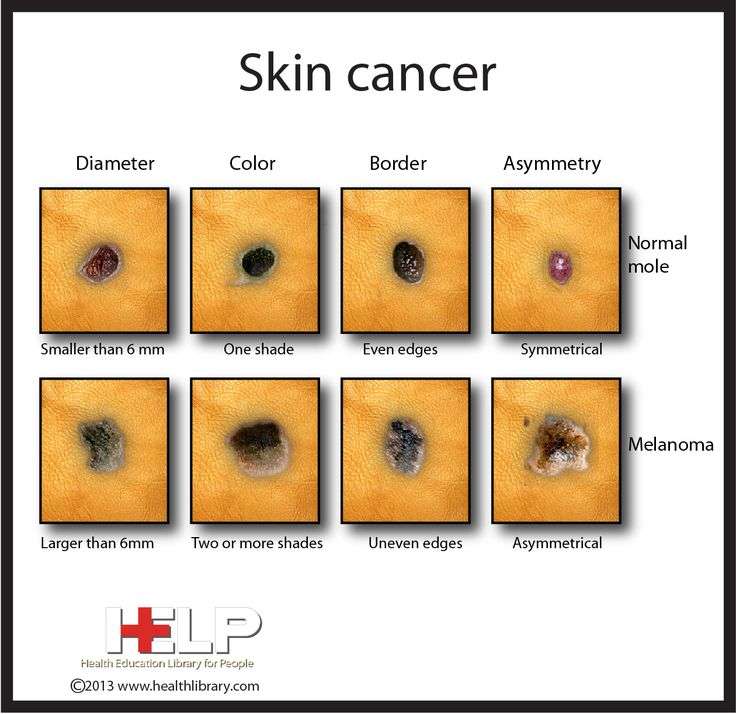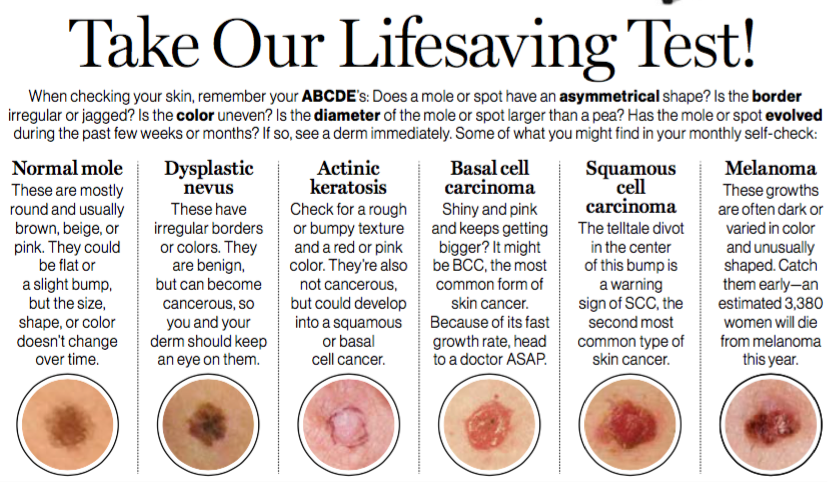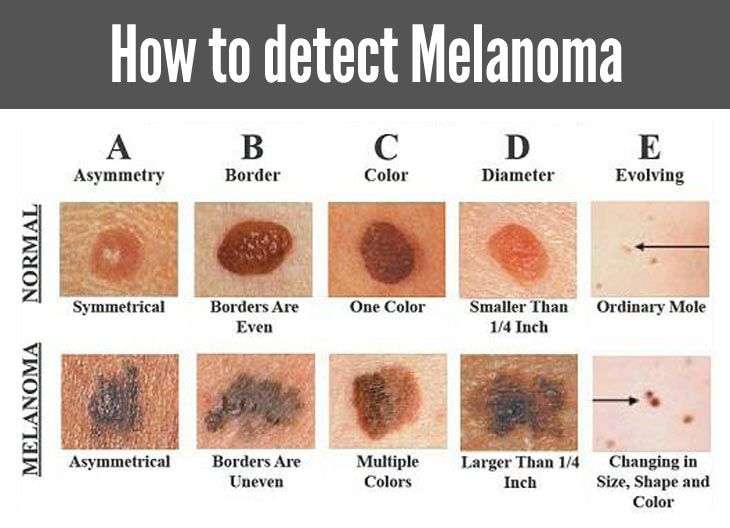Finding Skin Cancer Early
When skin cancer is found and treated early, the chances of successful treatment are better. Get regular health checkups and see your doctor if you have any symptoms or are worried about your health.
If you have a higher than average risk, you may need to visit your doctor more often to check for skin cancer. Talk to your doctor about what can help find skin cancer early including checking your skin and having skin exams by a trained health professional.
Who Is At Risk For Skin Cancer
Although anyone can get skin cancer, the risk is greatest in people who have fair or freckled skin that burns easily, light eyes and blond or red hair. Darker-skinned individuals are also susceptible to all types of skin cancer, although their risk is lower.
In addition to complexion, other risk factors include having a family history or personal history of skin cancer, having an outdoor job, and living in a sunny climate. A history of severe sunburns and an abundance of large and irregularly shaped moles are risk factors unique to melanoma.
How Can I Find Skin Cancer Early
- Talk with your doctor if you see any changes on your skin that do not go away within one month.
- Check the skin on all surfaces of your body, even in your mouth.
- Watch for a new mole or other new growth on your skin.
- Check for changes in the appearance of an old growth on the skin or scar .
- Watch for a patch of skin that is a different color and becomes darker or changes color.
- Watch for a sore that does not heal it may bleed or form a crust.
- Check your nails for a dark band. Check with your doctor if you see changes, such as if the dark band begins to spread.
When skin cancer is found early, it can be treated more easily.
You May Like: How To Identify Basal Cell Carcinoma
Can Changing My Diet Help Prevent Melanoma
The American Cancer Society advocates eating a plant-based diet over an animal-based diet as part of a healthy plan to avoid all cancers. Growing evidence suggests that plants pack a powerful punch in any fight against cancer because they’re nutritious, cholesterol-free and fiber-rich.
Theres no doubt that a healthy diet can protect your immune system. Having a strong immune system is important to help your body fight disease. Some research has shown that a Mediterranean diet is a healthy choice that may help prevent the development of cancer. Talk to your healthcare provider about the role food plays in lowering your cancer risks.
Some skin and immune-system healthy foods to consider include:
- Daily tea drinking: The polyphenols in tea help strengthen your immune system. Green tea contains more polyphenols than black tea.
- High vegetable consumption: Eating carrots, cruciferous and leafy vegetables is linked to the prevention of cutaneous melanoma.
- Weekly fish intake: Study participants who ate fish weekly seemed to avoid developing the disease when compared to those who did not eat fish weekly.
What Causes Skin Cancer

Most skin cancers occur on sun-exposed areas of skin, and there is a lot of scientific evidence to support ultraviolet radiation as a causative factor in most types of skin cancer. Family history is also important, particularly in melanoma. The lighter your skin type, the more susceptible you are to UV damage and to skin cancer. You have a higher risk of developing skin cancer, and should be particularly careful about sun exposure, if you have any of these factors:
- Long-term sun exposure
- Fair skin and lighter eye color
- Place of residence
- Presence of moles, particularly if there are irregular edges, uneven coloring, or an increase in the size of the mole
- Family history of skin cancer, particularly melanoma
- Use of indoor tanning devices
- Severe sunburns as a child
- Non-healing ulcers or nodules in the skin
- History of organ transplant or other immune system suppression
What Are the Different Types of Skin Cancer?
There are several types of cancer that originate in the skin. The most common types are basal cell carcinoma and squamous cell carcinoma. These types are classified as non-melanoma skin cancer. Melanoma is the third type of skin cancer. It is less common than basal cell or squamous cell cancers, but potentially much more serious. Other types of skin cancer are rare.
css id:
You May Like: Etiology Of Basal Cell Carcinoma
When Melanoma Can’t Be Cured
If your cancer has spread and it is not possible to cure it by surgery, your doctor may still recommend treatment. In this case, treatment may help to relieve symptoms, might make you feel better and may allow you to live longer.Whether or not you choose to have anti-cancer treatment, symptoms can still be controlled. For example, if you have pain, there are effective treatments for this. General practitioners, specialists and palliative care teams in hospitals all play important roles in helping people with cancer.
Am I At Risk For Skin Cancer
Anyone can get skin cancer, regardless of skin color. However, some factors increase your risk, including:
- A personal history of skin cancer
- Skin that burns, freckles, reddens easily, or becomes painful in the sun
- Blue or green eyes
- A history of indoor tanning
- Certain types and a large number of moles
- A family history of skin cancer
- Having had a lung, heart, kidney, pancreas or liver transplant
You May Like: Does Skin Cancer Make You Lose Hair
What Happens After The Cancer Has Been Diagnosed And Staged
Treatment for skin cancer depends on the skin cancer type, location, size, risk of recurrence, and stage. Removal of the skin tumor cures most cases of basal cell carcinoma or squamous cell carcinoma.11 Many melanomas can be cured with surgery, if caught early. Melanoma that has metastasized may require additional treatment with medication or radiation therapy.5
Make An Appointment With A Dermatologist
After you have performed regular skin checks and once you discover a suspicious lesion, you have done your job. Now its time to see a dermatologist, a skin care specialist who can determine the definitive diagnosis. This may require a minor outpatient surgical procedure known as a biopsy. Occasionally, a more significant surgery will be required.
The biopsy specimen will be sent to the pathology lab who can determine whether or not the lesion was a skin cancer and, if it was, what type. Found early, skin cancer, even melanoma, is very treatable.
As for Peggy and Tina, happy to announce, neither were diagnosed with skin cancer.
You May Like: Does Amelanotic Melanoma Blanch When Pressed
The Ugly Duckling Method
The ugly duckling method works on the premise that a personâs moles tend to resemble one another. If one mole stands out in any way, it may indicate skin cancer.
Of course, not all moles and growths are cancerous. However, if a person notices any of the above characteristics, they should speak with a doctor.
Biological Therapies And Melanoma
Biological therapies are treatments using substances made naturally by the body. Some of these treatments are called immunotherapy because they help the immune system fight the cancer, or they occur naturally as part of the immune system. There are many biological therapies being researched and trialled, which in the future may help treat people with melanoma. They include monoclonal antibodies and vaccine therapy.
You May Like: Does Skin Cancer Burn And Itch
You Can Find Skin Cancer On Your Body
The best way to find skin cancer is to examine yourself. When checking, you want to look at the spots on your skin. And you want to check everywhere from your scalp to the spaces between your toes and the bottoms of your feet.
If possible, having a partner can be helpful. Your partner can examine hard-to-see areas like your scalp and back.
Getting in the habit of checking your skin will help you notice changes. Checking monthly can be beneficial. If you have had skin cancer, your dermatologist can tell you how often you should check your skin.
People of all ages get skin cancer
Checking your skin can help you find skin cancer early when its highly treatable.
How To Check Your Skin

- Make sure you check your entire body, as skin cancers can sometimes occur on parts of the body that are not exposed to the sun, such as the soles of the feet, between fingers and toes and under nails.
- Undress completely and make sure you have good light.
- Use a mirror to check hard to see spots, like your back and scalp, or get a family member, partner or friend to check for you.
Read Also: Soderstrom Skin Cancer Screening
How To Find A Dermatologist
If you find a suspicious spot, seeing a dermatologist can give you peace of mind. Dermatologists are experts in caring for the skin and have more experience diagnosing skin cancer than any other doctor.
ReferencesAmerican Academy of Dermatology, AAD statement on USPSTF recommendation on skin cancer screening. News release issued July 26, 2016. Last accessed February 28, 2017.
Bichakjian CK, Halpern AC, et al. Guidelines of care for the management of primary cutaneous melanoma.J Am Acad Dermatol. 2011 Nov 65:1032-47.
Garg A, Levin NA, et al. Approach to dermatologic diagnosis. In: Wolff K, Goldsmith LA, et al. Fitzpatricks Dermatology in General Medicine . McGraw Hill Medical, New York, 2008: 25.
Staging For Basal Cell Carcinoma And Squamous Cell Carcinoma Of The Skin Depends On Where The Cancer Formed
Staging for basal cell carcinoma and squamous cell carcinoma of the eyelid is different from staging for basal cell carcinoma and squamous cell carcinoma found on other areas of the head or neck. There is no staging system for basal cell carcinoma or squamous cell carcinoma that is not found on the head or neck.
Surgery to remove the primary tumor and abnormal lymph nodes is done so that tissue samples can be studied under a microscope. This is called pathologic staging and the findings are used for staging as described below. If staging is done before surgery to remove the tumor, it is called clinical staging. The clinical stage may be different from the pathologic stage.
Recommended Reading: Can Squamous Cell Carcinoma Metastasis
Can I Qualify For Life Insurance After Being Diagnosed With Skin Cancer
Yes, it is possible. If you were diagnosed with melanoma, you may be able to get coverage though you may have to pay higher premiums. Some factors considered by insurers include the specific type of skin cancer you had, the stage and grade of your cancer, when you were diagnosed, when your last treatment was and your risk factor for getting skin cancer again.
After a skin cancer diagnosis, the insurer may choose from one of 4 options when choosing whether or not to extend coverage:
Questions you might be asked when you apply
Questions To Ask The Doctor
- Do you know the stage of the cancer?
- If not, how and when will you find out the stage of the cancer?
- Would you explain to me what the stage means in my case?
- What will happen next?
There are many ways to treat skin cancer. The main types of treatment are:
- Surgery
- Immunotherapy
- Chemotherapy
Most basal cell and squamous cell cancers can be cured with surgery or other types of treatments that affect only the spot on the skin.
The treatment plan thats best for you will depend on:
- The stage and grade of the cancer
- The chance that a type of treatment will cure the cancer or help in some way
- Your age and overall health
- Your feelings about the treatment and the side effects that come with it
Also Check: Does Amelanotic Melanoma Blanch When Pressed
How Are Moles Evaluated
If you find a mole or spot that has any ABCDE’s of melanoma — or one that’s tender, itching, oozing, scaly, doesn’t heal or has redness or swelling beyond the mole — see a doctor. Your doctor may want to remove a tissue sample from the mole and biopsy it. If found to be cancerous, the entire mole and a rim of normal skin around it will be removed and the wound stitched closed. Additional treatment may be needed.
Skin Warning Sign #: Changes In Your Skins Appearance
The most obvious skin cancer warning sign is that you should watch out for changes in the appearance of your skin, like moles or lesions.
You can identify potential skin cancers in any part of your skin by using the ABCDE method:
- Asymmetry Look for any abnormalities including irregular shapes
- Border Check if the mole or spot has an irregular or poorly defined border
- Colour Any uneven colours of black, brown, pink, red, and white on your skin can be a sign
- Diameter Check for changes in the size and diameter of spots
- Evolving Any moles or spots that have grown or changed in any way over time
Also Check: What Is The Most Aggressive Skin Cancer
Skin Cancer Is A Disease In Which Malignant Cells Form In The Tissues Of The Skin
The skin is the bodys largest organ. It protects against heat, sunlight, injury, and infection. Skin also helps control body temperature and stores water, fat, and vitamin D. The skin has several layers, but the two main layers are the epidermis and the dermis . Skin cancer begins in the epidermis, which is made up of three kinds of cells:
- Squamous cells: Thin, flat cells that form the top layer of the epidermis.
- Basal cells: Round cells under the squamous cells.
- Melanocytes: Cells that make melanin and are found in the lower part of the epidermis. Melanin is the pigment that gives skin its natural color. When skin is exposed to the sun, melanocytes make more pigment and cause the skin to darken.
Skin cancer can occur anywhere on the body, but it is most common in skin that is often exposed to sunlight, such as the face, neck, and hands.
See A Suspicious Spot See A Dermatologist

If you find a spot on your skin that could be skin cancer, its time to see a dermatologist. Found early, skin cancer is highly treatable. Often a dermatologist can treat an early skin cancer by removing the cancer and a bit of normal-looking skin.
Given time to grow, treatment for skin cancer becomes more difficult.
Read Also: Basal Skin Cancer Survival Rates
What Should I Look For When Checking My Skin
Look for any new moles or changes in your skin, especially any of the following:
- A new lump, growth or spot
- A change in size, shape, and/or color of an existing mole, lump or growth
- A sore that doesnt heal
- A red or brown patch thats rough and scaly
- A pink pearly bump that bleeds easily
- Any mole or spot that is asymmetrical, or has an irregular border or uneven color
- Any mole or spot larger than ¼ of an inch
Certain Factors Affect Prognosis And Treatment Options
The prognosis for squamous cell carcinoma of the skin depends mostly on the following:
- Stage of the cancer.
- Whether the patient is immunosuppressed.
- Whether the patient uses tobacco.
- The patients general health.
Treatment options for basal cell carcinoma and squamous cell carcinoma of the skin depend on the following:
- The type of cancer.
Also Check: What Is The Treatment For Lobular Carcinoma In Situ
Don’t Miss: Is This Skin Cancer App
What Are The Signs And Symptoms Of Basal Cell Carcinoma
Basal cell carcinoma is a type of skin cancer that can show up on the skin in many ways. Also known as BCC, this skin cancer tends to grow slowly and can be mistaken for a harmless pimple, scar, or sore.
Common signs and symptoms of basal cell carcinoma
This skin cancer often develops on the head or neck and looks like a shiny, raised, and round growth.
To help you spot BCC before it grows deep into your skin, dermatologists share these 7 warning signs that could be easily missed.
If you find any of the following signs on your skin, see a board-certified dermatologist.
How Is Skin Cancer Of The Head And Neck Diagnosed
Diagnosis is made by clinical exam and a biopsy. Basal cell and squamous cell cancers are staged by size and extent of growth. Basal cell cancers rarely metastasize to lymph nodes, but they can grow quite large and invade local structures. Squamous cell cancers have a much higher incidence of lymph node involvement in the neck and parotid gland and can spread along nerves.
Melanoma is staged, based not on size but on how deeply it invades the skin layers. Therefore, a superficial or shave biopsy will not provide accurate staging information used to guide treatment. Melanomas can have a very unpredictable course and may spread to distant organs. Melanomas with intermediate thickness often require sentinel node biopsy, a surgical procedure performed by a head and neck surgeon, to determine if microscopic spreading to lymph nodes has occurred.
Read Also: How Does Skin Cancer Feel